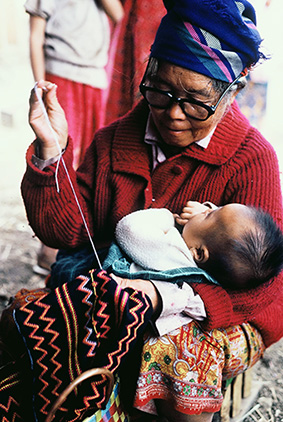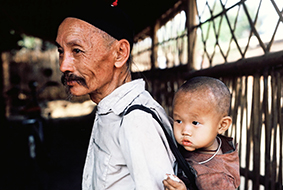This issue of the Hmong Times begins a series of images and recollections of those who came out of Laos and made their way to Minnesota and around the U.S., in an effort to preserve that history and to reestablish the unique bond between the oldest and youngest generations.
These photographs and stories are part of an ongoing collection of Minors, a Saint Paul based non-profit organization working in support of exceptionally impoverished Hmong and other highland ethnic minority children in Southeast Asia. *
To gain support for their projects serving remote mountain schools, Minors is producing a book, which details in photographs and memories the refugee and resettlement experience of the Hmong who came to the U.S. after the war to start a new life.
The book will hopefully be of value to schools serving Hmong and other Southeast Asian communities in the U.S., so that today’s generation may have knowledge of those who came before them, and the challenges they faced as they fled Laos and as refugees in the camps in northern Thailand.
These United Nations’ administered camps include Ban Vinai, Chiang Kham, Nong Khai, and Panat Nikhom, among others. From this collection of memories and images emerges the story of escape, refuge and resettlement of the Hmong to the U.S.
Those first-generation Hmong Americans have been sharing their experiences in a unique project undertaken by Minors, along with university and high school volunteers in Minnesota, including an entire class at Harding High School.
Ms. Youa Lee asked her Advanced Hmong Language class to interview their grandparents and other relatives, about their memories of escape from Laos, the years in the refugee camps and the agonizing decisions to leave family members behind for a new life for their children in the U.S.
The students in Ms. Lee’s class, all Hmong, enthusiastically agreed to participate and then interviewed their elders on video transcribed the recollections into Hmong and then into English. This was no small task, as we will see in our next installment.
The students’ cell phone videos provide a record that can be compared with the written transcripts in both languages, which made the class exercise as well as the book project verifiable.
Both Sides Of The Pond
This effort will have educational benefits for Hmong students on both sides of the Pacific, here in the U.S. and in remote mountain communities in Viet-Nam and Laos. It will be a lesson in history and cultural heritage for Hmong students at primary, middle and high schools in Minnesota, California and Wisconsin, among other states; one that will illustrate in great detail the trials their elders faced, not only in the war but in the years following.
For the Hmong and other highland students who struggle just to stay in school in northern Viet-Nam and Laos it will mean provision of the most basic necessities: access to food, water, shelter, clothing and health care, as sales of this book will support Minors’ projects at hundreds of remote mountain schools.
This first group of photos shows the close relationship between the elders in the refugee camps and the youngest and most vulnerable children for whom they provided daily care while parents went about the daily grind of getting by in the camps.
The closeness between these generations in today’s world is often not what it was a few decades ago, and so another goal of our book is to reestablish this traditional bond.
The long hours put in by the Harding students and their teacher have gone a good distance in reaching this end, and their challenges faced and lessons learned will be explored in the next installment of this series. We hope that anyone who recognizes the folks in these photos will be in contact with us so we may find and give them their photos, and hopefully hear their stories.
It is not surprising that the elder Hmong in Minnesota these many decades after the refugee exodus are still finding a way to help the youngest and most vulnerable children, even though an ocean away: the Peb Moob Senior Center on Payne Avenue, and the Hmong Elders’ Center on Rice Street, both in Saint Paul, have supported projects in the past year which have provided sustainable projects at schools serving Hmong children in northern Viet-Nam, enabling exceptionally impoverished children to stay enrolled at their remote mountain schools.
More about their projects in future issues, and more about the students in Minnesota schools and their reconnecting with their elders in the next issue.
*Please take a look at our web site to get a comprehensive view of our program, serving Hmong and other highland ethnic minority children in Southeast Asia:
http://minorsasia.org/index.html








